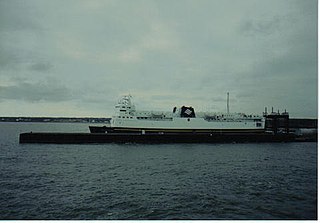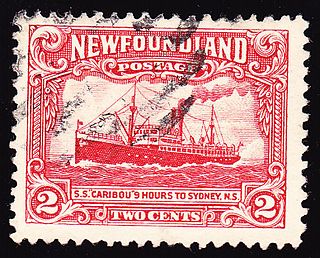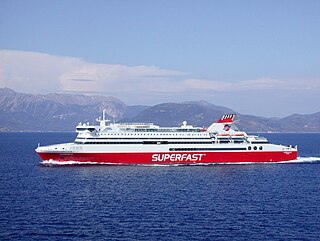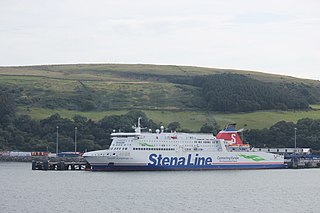
Marine Atlantic Inc. is an independent Canadian federal Crown corporation which is mandated to operate ferry services between the provinces of Newfoundland and Labrador and Nova Scotia.

Channel-Port aux Basques is a town at the extreme southwestern tip of Newfoundland fronting on the western end of the Cabot Strait. A Marine Atlantic ferry terminal is located in the town which is the primary entry point onto the island of Newfoundland and the western terminus of the Newfoundland and Labrador Route 1 in the province. The town was incorporated in 1945 and its population in the 2021 census was 3,547.

CN Marine was a Canadian ferry company headquartered in Moncton, New Brunswick.

MV Joseph and Clara Smallwood was a Marine Atlantic passenger/vehicle ferry which operated between Newfoundland and Cape Breton Island in eastern Canada. She is named after former Newfoundland premier Joseph R. Smallwood and his wife Clara.

MV Caribou was a Marine Atlantic passenger/vehicle ferry which operated between the islands of Newfoundland and Cape Breton in eastern Canada.
Tallink is an Estonian shipping company operating Baltic Sea cruiseferries and ropax ships from Estonia to Finland, Estonia to Sweden and Finland to Sweden. It is the largest passenger and cargo shipping company in the Baltic Sea region. It owns Silja Line and a part of SeaRail. Tallink Hotels runs four hotels in Tallinn. It is also the co-owner of a taxi company Tallink Takso.

MV John Hamilton Gray was an icebreaking railway, vehicle, and passenger ferry which operated across the Abegweit Passage of Northumberland Strait, connecting Port Borden to Cape Tormentine between 1968–1997.

SS Caribou was a Newfoundland Railway passenger ferry that ran between Port aux Basques, in the Dominion of Newfoundland, and North Sydney, Nova Scotia between 1928 and 1942. During the Battle of the St. Lawrence the ferry participated in thrice-weekly convoys between Nova Scotia and Newfoundland. A German submarine attacked the convoy on 14 October 1942 and Caribou was sunk. She had women and children on board, and many of them were among the 137 who died. Her sinking, and large death toll, made it clear that the war had really arrived on Canada's and Newfoundland's home front. Her sinking is cited by many historians as the most significant sinking in Canadian-controlled waters during the Second World War.

Superfast Ferries is a Greece-based ferry company founded in 1993 by Pericles Panagopulos and Alexander Panagopulos. Superfast Ferries is a member of Attica Group and operates 5 car-passenger ferries, offering daily connections between Ancona and Bari in Italy, and Patras and Igoumenitsa in Greece. Together with Blue Star Ferries, Africa Morocco Link, ANEK Lines and Hellenic Seaways, it is a subsidiary company of Attica Group, which is listed on the Athens Stock Exchange.

MV Northern Ranger was a Canadian ice-breaking coastal ferry operating in Newfoundland and Labrador. The ship entered service in 1986 for coastal service in Labrador. The vessel provided service between Nain, Newfoundland and Labrador and Happy Valley-Goose Bay, stopping at points between. The ferry was owned and operated by the province of Newfoundland and Labrador. At the end of 2018, the ship was taken out of service and replaced by a newer vessel on the route between Nain and Happy Valley-Goose Bay.

The MV Leif Ericson is a commercial passenger/vehicle ferry in service with the Canadian operator Marine Atlantic. She is currently the oldest vessel in the Marine Atlantic fleet. She was built along with two sister ships by Fosen Mekaniske Verksteder, Norway in the early 1990s. These two are Oslofjord and Patria Seaways.
MS Stena Superfast VII is a fast Ro-Pax ferry owned by Stena Line and operated on their service between Belfast and Cairnryan. Built in 2001 by Howaldtswerke-Deutsche Werft (HDW) in Kiel, Germany for Attica Group's subsidiary Superfast Ferries, The ship was sold to its current owners in 2017.

MS Stena Superfast VIII is a fast Ro-Pax ferry owned and operated by Stena Line between Belfast and Cairnryan. The ship was built in 2001 by Howaldtswerke-Deutsche Werft (HDW), Kiel, Germany for Attica Group's subsidiary Superfast Ferries. She was sold to her current owners in 2017.

MV Pelagitis is a roll-on/roll-off (Ro-Ro) ferry formerly operated by Marine Atlantic from North Sydney, Nova Scotia to Channel-Port aux Basques, Newfoundland, Canada. The vessel was completed in 1978 by Hyundai Shipbuilding Company Limited in and delivered to the Stena Line which operates in Northern Europe. She was sold on 12 March 2010 and given her current name Pelagitis.

MS A Nepita is a fast ropax ferry for Corsica Linea. The ferry was refurbished in Gdańsk, Poland for her new service and was returned to her original design before her SeaFrance career and looks identical to her sisters Stena Superfast VII & VIII. Before November 2014 she operated between Dover and Calais for DFDS Seaways France and between 2008 and 2012 for SeaFrance.

MV Blue Puttees is a Ro-Pax passenger/vehicle ferry operated by Marine Atlantic between the islands of Newfoundland and Cape Breton in eastern Canada. She is named after the nickname of the Royal Newfoundland Regiment.

MV Highlanders is a Ro-Pax passenger/vehicle ferry operated by the Canadian Crown corporation Marine Atlantic. She operates between the islands of Newfoundland and Cape Breton in eastern Canada and is named after several Nova Scotian infantry regiments which fought in the first and second world wars.

MV Patrick Morris was a train ferry regulated by the Canadian National Railway (CN) that sank on her run from North Sydney, Nova Scotia to Port aux Basques, Newfoundland during a storm in the early morning of 20 April 1970 while responding to a mayday call from the Newfoundland-based herring seiner FV Enterprise. The ship's Captain Roland Penney was given permission to leave North Sydney ahead of schedule to assist the distressed wood-hulled fishing vessel .No passengers were aboard Patrick Morris when she set sail shortly before midnight for the rescue mission on 19 April.

MV Apollo was a vehicle/passenger ferry that previously serviced the route between St. Barbe, Newfoundland and Labrador and Blanc-Sablon, Quebec, Canada.

Route 470, also known as La Poile Highway, is a highway on the West Coast of the Canadian province of Newfoundland and Labrador. It is the last provincial highway off Route 1 before approaching the Marine Atlantic Ferry to Nova Scotia, in Channel-Port aux Basques. The route is 42.8 kilometres (26.6 mi) in length. During much of the journey, there is plenty of barren land on both sides of the road, until arriving at its final community, Rose Blanche. Route 470 also carries the designation of Granite Coast Scenic Drive.

























